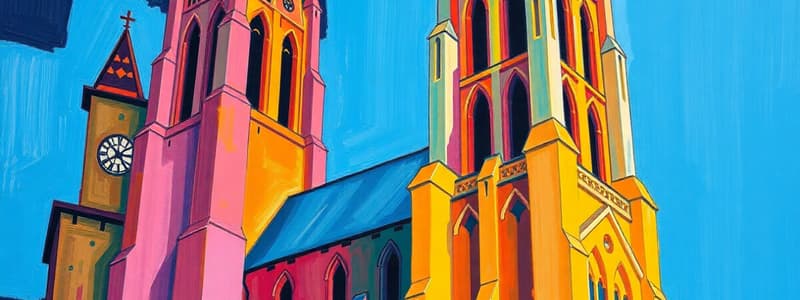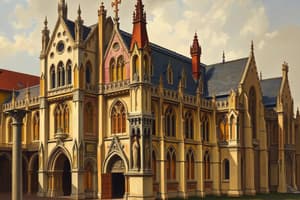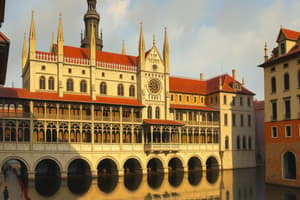Podcast
Questions and Answers
What characteristic distinguishes the equilateral arch from the semi-circular arch?
What characteristic distinguishes the equilateral arch from the semi-circular arch?
- It has a larger radius than a semi-circular arch.
- Its height is greater in relation to its width. (correct)
- It is exclusively used in vaulting.
- It is wider than it is high.
Which type of arch is characterized by a sharp, flame-like point?
Which type of arch is characterized by a sharp, flame-like point?
- Depressed Arch
- Equilateral Arch
- Flamboyant Arch (correct)
- Pointed Arch
What is a primary structural advantage of pointed arches used in Gothic architecture?
What is a primary structural advantage of pointed arches used in Gothic architecture?
- They can be constructed with thicker walls.
- They support the weight of the roof more effectively. (correct)
- They decrease the need for buttresses.
- They allow for larger window openings.
How do depressed arches visually appear?
How do depressed arches visually appear?
What type of tracery features a geometric arrangement in Gothic windows?
What type of tracery features a geometric arrangement in Gothic windows?
What characterized the Flamboyant style of Gothic architecture?
What characterized the Flamboyant style of Gothic architecture?
What primary structural difference distinguishes ribbed vaulting from barrel vaulting?
What primary structural difference distinguishes ribbed vaulting from barrel vaulting?
Which architectural feature did Gothic builders introduce that differs from earlier Romanesque churches?
Which architectural feature did Gothic builders introduce that differs from earlier Romanesque churches?
How did Gothic architecture reflect medieval man's view of divine light?
How did Gothic architecture reflect medieval man's view of divine light?
Which phase of French Gothic architecture was characterized by circular windows with radiating lines of tracery?
Which phase of French Gothic architecture was characterized by circular windows with radiating lines of tracery?
What did Gothic builders discover about pointed arches that earlier Romanesque builders did not capitalize on?
What did Gothic builders discover about pointed arches that earlier Romanesque builders did not capitalize on?
What is the significance of the ambulatory of the abbey of Saint-Denis in the context of Gothic architecture?
What is the significance of the ambulatory of the abbey of Saint-Denis in the context of Gothic architecture?
Which architectural feature is primarily associated with Gothic buildings?
Which architectural feature is primarily associated with Gothic buildings?
What was one defining feature of the Early English Gothic architecture?
What was one defining feature of the Early English Gothic architecture?
What was a key characteristic of the Gothic Revival style during the nineteenth century?
What was a key characteristic of the Gothic Revival style during the nineteenth century?
Which Gothic architecture style is also referred to as Rectilinear Style?
Which Gothic architecture style is also referred to as Rectilinear Style?
What role did gargoyles serve in Gothic architecture?
What role did gargoyles serve in Gothic architecture?
How did Abbot Suger influence Gothic architecture?
How did Abbot Suger influence Gothic architecture?
What material was predominantly used in Northern Germany and nearby regions for Gothic architecture?
What material was predominantly used in Northern Germany and nearby regions for Gothic architecture?
In what way did the concept of divine light manifest in Gothic churches compared to Romanesque churches?
In what way did the concept of divine light manifest in Gothic churches compared to Romanesque churches?
What term was originally used in the 1530s by Giorgio Vasari to describe a style considered rude and barbaric?
What term was originally used in the 1530s by Giorgio Vasari to describe a style considered rude and barbaric?
What is a significant consequence of the new techniques of construction in Gothic architecture?
What is a significant consequence of the new techniques of construction in Gothic architecture?
Which architectural feature was NOT typical of Gothic architecture?
Which architectural feature was NOT typical of Gothic architecture?
Which of the following styles is characterized by the use of rich tracery and refined stonecutting techniques during the late 13th to late 14th centuries in England?
Which of the following styles is characterized by the use of rich tracery and refined stonecutting techniques during the late 13th to late 14th centuries in England?
In Gothic architecture, which style emerged as a response to the increasing complexity and height of structures during the High and Late Medieval periods?
In Gothic architecture, which style emerged as a response to the increasing complexity and height of structures during the High and Late Medieval periods?
What primary architectural feature distinguishes Gothic churches from Romanesque churches?
What primary architectural feature distinguishes Gothic churches from Romanesque churches?
Which of the following elements is NOT commonly associated with Gothic church architecture?
Which of the following elements is NOT commonly associated with Gothic church architecture?
What is the primary plan design of most Gothic churches?
What is the primary plan design of most Gothic churches?
How does the use of the pointed ribbed vault in Gothic architecture benefit the structure?
How does the use of the pointed ribbed vault in Gothic architecture benefit the structure?
What characteristic ratio of height to width is often seen in English Gothic churches?
What characteristic ratio of height to width is often seen in English Gothic churches?
Which element is primarily used to create intricate designs in Gothic windows?
Which element is primarily used to create intricate designs in Gothic windows?
What visual impression is typically aimed for by the façade of a Gothic cathedral's West Front?
What visual impression is typically aimed for by the façade of a Gothic cathedral's West Front?
Which style of arch is commonly grouped in clusters in Gothic architecture?
Which style of arch is commonly grouped in clusters in Gothic architecture?
Which of the following best describes the approach to light in Gothic architecture?
Which of the following best describes the approach to light in Gothic architecture?
What construction element allows Gothic churches to have thinner walls compared to Romanesque churches?
What construction element allows Gothic churches to have thinner walls compared to Romanesque churches?
Flashcards are hidden until you start studying
Study Notes
Gothic Architecture
- A style of architecture that thrived during the High and Late Medieval periods (12th to 16th century)
- Developed from Romanesque architecture and was succeeded by Renaissance architecture
Origins and Key Features
- Originated in France during the 12th century and spread throughout Western Europe
- Characterized by:
- Progressively lighter and taller structures
- Use of pointed arches, ribbed vaults, and elaborate fenestration (windows)
Abbot Suger and the Rise of Gothic
- Considered the "father" of Gothic architecture
- His innovative choir for the abbey church of St. Denis, France, marked a shift in architectural style
- Reflected the rise of France as a political and cultural force in Europe
- Inaugurated a period of widespread cathedral building in France that lasted until the 13th century
Periods of Gothic Architecture
French Gothic Architecture
- Early French Style (12th Century): Characterized by pointed arches and geometric tracery
- Rayonnant Style (Late 13th-14th Century): Known for its circular windows with radiating lines of tracery
- Flamboyant Style (14th-16th Century): Distinguished by flame-like tracery, intricate detailing, and complex interior spaces
English Gothic Architecture
- Early English Style (Late 12th-13th Century): Characterized by lancet windows and plate tracery
- Decorated Style (Late 13th-Late 14th Century): Known for its rich tracery, elaborate ornamental vaulting, and refined stonecutting
- Geometric Style (Late 13th-Early 14th Century): Characterized by the use of geometric tracery
- Curvilinear Style (Second half of 14th Century): Characterized by the use of curvilinear tracery
- Perpendicular Style (Late 14th-Early 16th Century): Also known as Rectilinear Style, characterized by perpendicular tracery, intricate stonework, and elaborate fan vaults
The Term "Gothic"
- Coined in the 1530s by Giorgio Vasari to describe what was considered rude and barbaric
- In 17th-century England, "Goth" was synonymous with "vandal," a term often used to describe the architectural styles of Northern Europe
Regions
- At the end of the 12th century, England was divided into various city-states and kingdoms
- Throughout Europe, there was a rapid growth in trade and an associated growth in towns
- Germany and the Lowlands, with their flourishing towns, saw a rise in trade and competition
Materials
- France: Ready availability of limestone
- England: Coarse limestone, red sandstone, and dark green Purbeck marble
- Northern Europe: Brick was the primary building material due to a scarcity of local building stones
- Brick Gothic: Called "Backsteingotik" in Germany and Scandinavia
- Italy: Stone was used for fortifications, but brick was preferred for other buildings; marble was also widely used due to its abundance
Religion
- Medieval period saw a rapid growth in monasticism with various orders spreading their influence
- Benedictines, Cistercians, Dominicans, Franciscans
Romanesque Tradition
- The basic structure of cathedrals, parish churches, monasteries, castles, palaces, and gatehouses were established during the Romanesque period
- Features borrowed from Romanesque architecture included:
- Ribbed vaults
- Buttresses
- Clustered columns
- Ambulatories
- Wheel windows
- Spires
- Richly carved door tympanums
Gothic Innovation
- Gothic broke from the tradition of massive masonry and solid walls with small openings
- Emphasized lightness and a sensation of light triumphing over substance
- Key features that distinguished Gothic from Romanesque architecture:
- Pointed arches
- Flying buttresses
- Pinnacles
- Traceried windows
Characteristics of Gothic Churches
- Emphasis on verticality and lightness
- Pointed arches
- Clustered columns
- Pointed ribbed vaults
- Flying buttresses
- Towers
- Pinnacles
- Spires
Plan of Gothic Churches
- Most churches follow a Latin cross plan with a long nave, transept, choir, chancel, or presbytery
- The nave is flanked by aisles on both sides
- Germanic Gothic churches, like St. Stephen of Vienna, have nave and aisles of similar height and are called "Hallenkirche"
Architectural Characteristics of Gothic Churches
Pointed Arch
- Used extensively in structural and decorative elements like doorways, windows, arcades, and galleries
- Developed complex Gothic tracery, which provided structural support for large windows
Vertical Emphasis
- Gothic churches are characterized by height, both in absolute terms and in proportion to their width
- The nave is typically taller than it is wide, with proportions sometimes exceeding 2:1
- Cologne Cathedral achieves a ratio of 3.6:1
Light
- Expansive window areas are one of the defining features of Gothic architecture
- Ribbed vaults, particularly pointed ribbed vaults, allowed for lighter walls and larger windows by channeling weight to supporting shafts
- This provided a sense of lightness and allowed for increased natural light in the interiors
Majesty
- Façades, often referred to as the "West Front," were designed to create a powerful impression on worshippers
- Emphasized the might of God and the institution it represented
Basic Shapes of Gothic Arches
Lancet Arch
- Often grouped in clusters of three or five
- Extremely narrow and steeply pointed
Equilateral Arch
- Radius of the arch is equal to the width of the opening
- Center of each arch coincides with the point from which the opposite arch springs
- Creates a higher arch in relation to its width compared to a semicircular arch
Flamboyant Arch
- Upper part of each main arc turns upwards into a smaller arc, meeting at a sharp, flame-like point
- Creates a lively effect when used in window tracery and surface decoration
- Rarely used for large openings due to its structural weakness
Depressed Arch
- Also known as a four-centered arch
- Wider than its height, creating the illusion of being flattened under pressure
- Constructed using two steeply rising arcs with small radii followed by two arches with a wider radius and lower springing point
Gothic Window Tracery
- Plate Tracery: Early form of tracery with simple, geometric patterns
- Geometric Tracery: More complex patterns created by intersecting lines and curves
- Intersecting Tracery: Created by the intersection of two or more arches
- Reticulated Tracery: Network of small squares or diamonds created by intersecting arches
Gothic Elements
- Abbey Church of St. Denis, France: The earliest complete Gothic structure, built between 1140 and 1144
- Pointed Arches: Discovered during the Gothic period, they provided exceptional strength and stability
- Ribbed Vaulting: Replaced barrel vaulting, allowing thinner walls and increased light by channeling weight to supporting columns
- Stained Glass Windows: A defining feature of Gothic churches, used to tell stories and depict religious themes
- Gargoyles: Ornamental and functional, serving as water spouts and adding a decorative element to the exterior of buildings
Gothic Revival
- A 19th-century architectural movement that revived Gothic styles
- Borrowed Medieval traditions, incorporating elements like arched windows, pinnacles, and gargoyles into new structures
- Influenced a wide range of building types, from churches to private homes
Studying That Suits You
Use AI to generate personalized quizzes and flashcards to suit your learning preferences.




